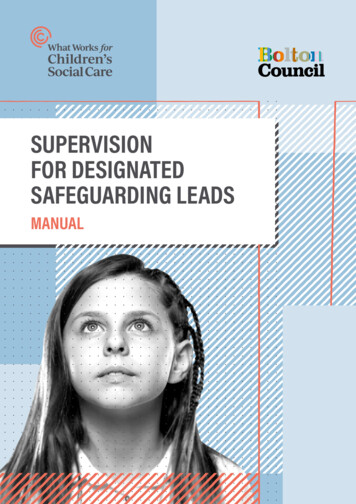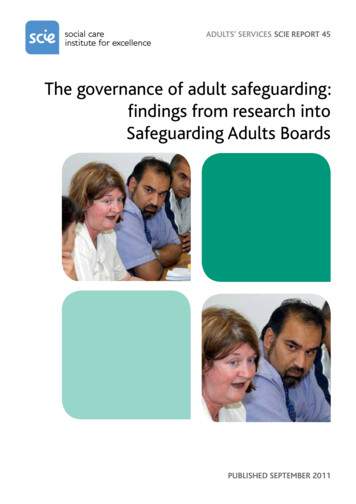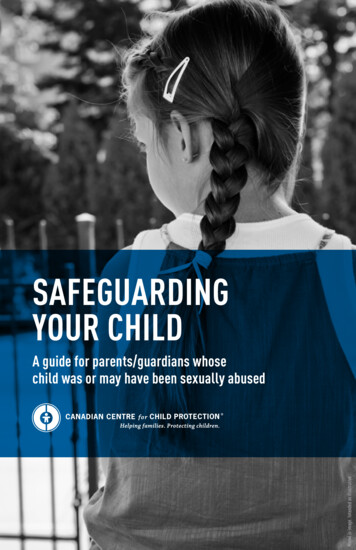
Transcription
SUPERVISIONFOR DESIGNATEDSAFEGUARDING LEADSMANUAL
CONTENTSForewordAbout UsChapter One:Programme OverviewTheory of ChangeEvaluation DesignFidelityChapter Two:Setting Up SupervisionArrangementsSupervision Framework forDesignated Safeguarding LeadsDefinition of SupervisionStatutory GuidanceThe Objectives of SupervisionEfective SupervisionRoles and ResponsibilitiesSupervision ModelsAd-Hoc or Unplanned SupervisionRecording SupervisionTime and PlaceQuality AssuranceCommon Document TemplatesChapter Three:Working With Primary SchoolsModel of SupervisionYoung People and FamiliesFrequencyPreparing for SupervisionSupervision AgreementsOther Support for DSLsPrimary School Document Templates123715Chapter Four:Working With Secondary SchoolsModel of SupervisionYoung People and FamiliesFrequencyPreparing for SupervisionSupervision AgreementsOther Support for DSLsSecondary School DocumentTemplatesChapter Five:SupportSupervision for SupervisingSocial WorkersCommunity of PracticeAddressing ConcernsVirtual SupervisionQuestions and TroubleshootingKey Contacts2126Appendix 1:Common templates28Appendix 2:Primary school templates37Appendix 3:Secondary school templates46
SUPERVISION FOR DESIGNATED SAFEGUARDING LEADS MANUALFOREWORDI remember when growing up my father had a green toolbox thathe used to fix everything from my first bike to my first car. Whenhe passed away I inherited the toolbox. But to my astonishment, itcontained only a handful of tools. On reflection, I now understandthat it’s not the quantity, but the quality of how he used those tools making the best of what he had, to get the best outcome.This translates to the way in which we work with childrenand families. It’s what we bring of ourselves to findsolutions - the tools are there to assist but they don’tprovide the answer to fixing the problem. I still have thetoolbox, I’ve just added a few more tools along the way.I am very pleased to introduce this manual that sets outto support Supervising Social Workers in the delivery ofsupervision to Designated Safeguarding Leads (DSLs)in schools.Fulfilling the DSL role can be challenging and ofteninvolves having to make dificult decisions about themost vulnerable children. Often DSLs do not receiveformal supervision and support.“The aim is to improvethe DSLs’ confidence(and reduce anxieties)in decision making”It is, without doubt, challenging to know what is ‘the right call’, asthe potential implications for children’s lives can be enormous. Thisapproach sets out to help bridge the gap between keeping childrensafe whilst supporting DSLs to feel safe in doing so.WILSON LITCHMORESupervisor to DesignatedSafeguarding Leadsin Schools (Bolton)From process to procedure, the aim is to improve the DSLs’ confidence(and reduce anxieties) in decision making by strengthening theirpractice, enhancing their knowledge and skills to be used moreefectively, and challenging them to reflect on their work with childrenand families.The manual is not an attempt to ofer a ‘best’ approach, a one-sizefits-all model, or a single agreed way to supervising DSLs - there areother examples and many supervision models developed from diferentperspectives. This manual supports the Supervising Social Worker toselect the best tools and approaches to reach the best outcomes1
FOREWORD ABOUT USI believe it is the unique supervisory relationship between the SocialWorker and Designated Safeguarding Leads which provides thefoundation that this work is built upon. It allows both to share theirprofessional expertise and experience, while coming from diferentperspectives. It also provides a shared goal - keeping children ‘in focus’when making decisions about their lives, when working in partnershipwith them and their families.1Thank you to all who have contributed to this important piece of work. Ihave been delighted to have been part of the DSL Supervision journey,as the first Supervising Social Worker in the original Bolton pilot, andlook forward to seeing this work flourish further as it develops.WILSON LITCHMORESupervisor to Designated SafeguardingLeads in Schools (Bolton)1Working Together to Safeguard Children, 2018ABOUT USThis manual is for local authorities taking part in a programme of workto provide Designated Safeguarding Leads in schools with supervision.It provides guidance on how supervision should be delivered andtemplate documents for use in setting up and maintaining good qualitysupervision. The manual will also be of interest to schools taking partin the programme.What Works for Children’s Social CareWhat Works for Children’s Social Care seeks better outcomes forchildren, young people and families by bringing the best availableevidence to practitioners and other decision makers across thechildren’s social care sector. We generate, collate and make accessiblethe best evidence for practitioners, policy makers and practice leadersto improve children’s social care and the outcomes it generates forchildren and families.Bolton Children’s ServicesBolton Children’s Services is part of Bolton Metropolitan BoroughCouncil and the Greater Manchester Combined Authority. It hasstatutory responsibility for safeguarding children in need and childrenin need of protection in the local authority area. It is situated in theNorthwest of England and has a population of 276,800 and a total of147 schools.2
SUPERVISION FOR DESIGNATED SAFEGUARDING LEADS MANUALCHAPTER ONE:PROGRAMMEOVERVIEW3
CHAPTER ONE PROGRAMME OVERVIEWNotesTHEORY OF CHANGEEvery school in England must have at least one DesignatedSafeguarding Lead (DSL) who has responsibility for safeguardingchildren and young people in their school. 2Statutory guidance highlights the importance of the role of a DSL,the training and support this individual ought to receive, and thecritical role of supervision to ensure the best outcomes for the childand family at risk. The ‘Keeping Children Safe in Education’ guidancestipulates that DSLs ‘should be given the time, funding, training,resources and support to provide advice and support to other staf onchild welfare and child protection matters ’. Further guidance suchas ‘Working Together to Safeguard Children’ (HM Government, 2018)also emphasises that, ‘efective practitioner supervision can play acritical role in ensuring a clear focus on a child’s welfare. Supervisionshould support practitioners to reflect critically on the impact of theirdecisions on the child and their family.’2Keeping Children Safein Education, 2020Despite this guidance, DSLs often do not receive formalsupervision to support them specifically with their child safeguardingresponsibilities and are often ill equipped and undertrained to carryout their role most efectively.This programme ofers supervision to DSLs in schools for an initialperiod of six months and the evaluation of the programme will look atwhether there is an impact on the referrals that DSLs make to children’ssocial care. The rationale for this is that if DSLs are supported to makesound decisions about the need for statutory intervention they will makeappropriate referrals. Therefore, the number of inappropriate referrals,assessed as requiring no further action, will reduce.It is also anticipated that efective supervision will have a positiveimpact on DSLs’ subjective wellbeing and therefore rates of stress,burnout and turnover.Little orno supportfor DSLsProvide highqualitysupervisionImprovedconfidenceand decisionmakingAppropriatereferalsmade to CSCTHE THEORY OF CHANGEImprovedDSLwellbeing4CSC resourcestargeted atchildren whoneed it
SUPERVISION FOR DESIGNATED SAFEGUARDING LEADS MANUALEVALUATION DESIGNSupervision for DSLs is being evaluated as part of this programmeof work. The evaluation design is a randomised controlled trial andthereby it will allow findings to show whether there is a causal linkbetween the intervention and a change in outcomes - in this instance,the outcome is the referrals that DSLs make to children’s social care.Randomisation is taking place at the school level. This means thatevery school involved in the trial has been randomly assigned to eitherthe intervention group or the comparison group. DSLs in schools in theintervention group will receive regular supervision for the duration ofthe trial. Schools in the comparison group will continue with businessas usual, which means DSLs will continue to use any support theyalready get from the local authority or from within their school. Datafrom schools in the intervention group will be compared with data fromschools in the comparison group to determine what, if any, efect theintervention has.HOW A RANDOMISED CONTROLLED TRIAL WORKSTreatmentAll primary/secondaryschools in alocal authorityResults fromthe evaluationare expected tobe published inAutumn 2022ReceivesupervisionSPLIT AT RANDOMOutcomedatacollectedControlTreatmentand controlgroupcomparedThe evaluation is being conducted by the National Institute ofEconomic and Social Research (NIESR). They will analyse data fromthe trial and use it to make findings on: Appropriateness of referrals made by DSLsto the children’s services Subjective wellbeing of DSLsFor some schools involved in the trial, NIESR will also be looking aschild sexual abuse and how frequently DSLs identify it as a concernwhen making a referral to children’s social care.5
CHAPTER ONE PROGRAMME OVERVIEWFIDELITYIn order for the evaluation to producereliable results, it is important that localauthorities and schools participatingdeliver the programme of work in the wayit was intended. This manual sets out theway in which supervision needs to becarried out and following it will thereforeensure the fidelity of the model andreliability of the results.6Notes
SUPERVISION FOR DESIGNATED SAFEGUARDING LEADS MANUALCHAPTER TWO:SETTING UPSUPERVISIONARRANGEMENTS7
CHAPTER T WO SET TING UP SUPERVISION ARRANGEMENTSNotesSUPERVISION FRAMEWORKFOR DESIGNATEDSAFEGUARDING LEADSSupervision in children’s social care is a fundamental task insupporting the development of staf skills and practices in work withchildren, young people and families and the safeguarding of thosein their care. This intervention applies the same principles to thesupervision of Designated Safeguarding Leads (DSLs) in schools, whoare responsible for safeguarding in their school.Efective supervision should provide support, encourage criticalreflection and curiosity and leave DSLs feeling more confident abouttheir safeguarding work.DEFINITION OF SUPERVISIONSupervision can mean diferent things to diferent people butessentially it is an activity that brings skilled supervisors (socialworkers) and practitioners (in this context, DSLs) together in orderto reflect upon their practice. It aims to help DSLs to process, putin context and learn from their experiences in their role. It is notan inspection or critique of the work of an individual DSL but amechanism to support good practice.8
SUPERVISION FOR DESIGNATED SAFEGUARDING LEADS MANUALSTATUTORY GUIDANCEWorking Together to Safeguard Children (2018) states efectivepractitioner supervision can play a critical role in ensuring a clear focuson a child’s welfare; Supervision should support practitioners to reflectcritically on the impact of their decisions on the child and their family.The Statutory Framework for Early Years Foundation Stage – EYFS(2017) states that ‘providers must put appropriate arrangements inplace for the supervision of staf who have contact with children andfamilies. Efective supervision provides support, coaching and trainingfor the practitioner and promotes the interests of children. Supervisionshould foster a culture of mutual support, teamwork and continuousimprovement, which encourages the confidential discussion ofsensitive issues.’Keeping Children Safe in Education (2018) states that DSLs ‘shouldbe given the time, funding, training, resources and support toprovide advice and support to other staf on child welfare and childprotection matters ’Supervisionshould foster aculture of mutualsupport, teamworkand continuousimprovement,which encouragesthe confidentialdiscussion ofsensitive issuesTHE OBJECTIVES OF SUPERVISIONThis programme will look at whether supervision for DSLs hasan impact on the appropriateness of referrals made by schools tochildren’s social care. It will also look at DSLs’ confidence levels andsubjective wellbeing.More general objectives of supervision are as follows and areapplicable to this programme:To identify the DSLs’ learning and development needsTo signpost the DSL to useful literature and research,and the policy and procedures, to support evidenceinformed practiceTo provide feedback to the DSLs on their continuingprofessional development9
CHAPTER T WO SET TING UP SUPERVISION ARRANGEMENTSEFFECTIVE SUPERVISIONIn order to understand whether supervision has an impact onoutcomes for children and young people, it is important that it isdelivered efectively and to a high standard. For the purposes of thisintervention, efective supervision will:Be facilitated by a qualified social worker withexperience of safeguarding in children’s social careFocus on the childConsistently be in line with local authorityand school proceduresBe a safe environment for restorative reflectionproviding high support and high challengeRecognise the potential consequences, both personallyand professionally, of the work and provide time toreflect on theseAcknowledge and ofer support and the opportunity toexplore feelings, beliefs and views which may impact onthe safeguarding of childrenEnsure children are at the heart of all engagement andwithin the work consider their family lives, their identity,Adverse Childhood Experiences (ACEs) and their ownpersonal experiencesDemonstrate an inclusive approach when working withchildren and young people and an understanding andcommitment to equality and diversityEnsure that if concerns about a child or young personneed to be escalated, this is done in a timely manner10Notes
SUPERVISION FOR DESIGNATED SAFEGUARDING LEADS MANUALROLES ANDRESPONSIBILITIESThe supervising social worker (SSW)Working with the DSL to ensure the supervisoryrelationship is efective and successfulPromoting a supportive, safe and confidentialspace for supervisionAgreeing frequency, times and format i e whethersupervision will be virtual or in personEnsuring that issues relating to identity are addressedconstructively and positively and provide an opportunityfor DSLs to raise issues about their experiencesKeeping an accurate record of the supervision and sharean agreed copy with the DSLEnsuring legislation is adhered to including GDPRguidelines and Article 8 of European Convention onHuman Rights (1953) (right to private and family life)whilst also being mindful of the paramountcy of thechild’s needs for protectionThe DSLWorking with the social worker to ensure thesupervisory relationship is efective and successfulPreparing for supervision sessions by bringingappropriate and relevant examples of safeguardingissues for discussionPrioritising supervision sessions and attending on time,guarding against interruptionsUsing supervision sessions to talk openly aboutsafeguarding issues and using the time to improvepractice and outcomes for childrenReviewing supervision records to ensure they are anaccurate record of the sessionEnsuring the school’s professional standards aremet alongside the professional standards of theLocal Authority11
CHAPTER T WO SET TING UP SUPERVISION ARRANGEMENTSPRIMARYSUPERVISION MODELSSCHOOLIn this programme, diferent models of supervision will be usedin diferent school settings. Primary school DSLs will receiveDSLSone-to-one supervision. More information about this can befound in Chapter Three.CHAPTER 3SECONDARYSCHOOLDSLSCHAPTER 4In secondary schools there are usually multiple people with DSLresponsibilities, including heads of year, pastoral staf and the seniorleadership team. Therefore, DSLs in secondary schools will receivegroup supervision. More information about this can be found inChapter Four.AD-HOC ORUNPLANNED SUPERVISIONIt is commonplace for DSLs to seek out their SSW for ad-hocconversations outside of formal supervision meetings. DSLs may wantto do this in order to check-out their thinking or ask advice. Ad-hoc orunplanned supervision will be recorded by the SSW and a copy sharedwith the school. The following points should be considered when adhoc or unplanned supervision occurs:Any decisions made with regard to a child or familyshould be clearly recordedIssues raised should be followed up in plannedsupervision sessionsThis does not negate or replace the formal agreedsupervision sessionsWays to promote independent decision making andavoid dependency on the SSW12
SUPERVISION FOR DESIGNATED SAFEGUARDING LEADS MANUALRECORDING SUPERVISIONAccurate and clear supervision records are important because they provideclarity on agreed actions, track progress and flag any problems or concerns. Theyare helpful when considering professional development, as well as for auditingpurposes.The following should be taken into account when recording supervision:All supervision sessions must be recorded by the SSWRecords of supervision should be updated by the SSW and promptlysaved by the DSL Records are generally paperless and electronicsignatures should be used if possibleQUALITYASSURANCEThe completed supervisionrecord is primarily adocument for the school’srecord. Supervisionfiles may be subject toinspection and audit andtherefore should be keptin good order. This is theresponsibility of the DSL.Records of supervision should be kept confidential and should bestored securely by the DSL on the school’s computer system andwill be subject to the school’s usual audit proceduresSupervising social workers should keep a copy of supervisionrecords on a secure drive, but not on the case management system(children discussed at supervision meetings may not be open onthe case management system)DSLs must gain parents’ consent before their details can beexplicitly shared with the supervisor and therefore recorded13
CHAPTER T WO SET TING UP SUPERVISION ARRANGEMENTSTIME AND PLACECreating the right environment for supervision is an importantelement but we must accept that this is not always possible withinschools. However, for many people, working arrangements havechanged as a result of the COVID-19 pandemic and manysupervision arrangements will continue to happen virtually.The following principles apply to both arrangements:Have a quiet private space to allow for openand honest discussionsEnsure a relaxed atmospherePrioritise the time and avoid interruptionsMake sure you keep to agreed start and end timesConsider when the supervision is scheduled soas not to clash with other commitmentsCOMMON DOCUMENT TEMPLATESTemplates can be downloaded rcesand found at Appendix 1.14TemplateDocumentForuse by:Memorandumof Understanding(MoU)Introductionfor DesignatedSafeguardingLeadsNotesStorageLocal authorityand participatingschoolLocal authorities should share the MoU withparticipating schools to explain the supervisionarrangements that will be put in place and to securetheir commitment to the programmes of workCopy to be keptby both partiesSSW and DSLSSW should share this document with the DSLsto explain the supervision arrangements that willbe put in placeCopy to be kept byboth parties
SUPERVISION FOR DESIGNATED SAFEGUARDING LEADS MANUALCHAPTER THREE:WORKING WITHPRIMARY SCHOOLS15
CHAPTER THREE WORKING WITH PRIMARY SCHOOLSNotesLOCAL AUTHORITIESWORKING WITH PRIMARYSCHOOLS WILL DELIVERONE-TO-ONE SUPERVISIONTO DESIGNATED SAFEGUARDINGLEADS IN SCHOOLSThe key functions of DSL supervision in this context are:Management Oversight and Accountability: checkinterventions are working efectively to improveoutcomes for children, such as intervention plans andsupport swift, efective action if plans are not workingContinuing Professional Development: DSLs have theknowledge to correctly apply thresholds and referralprocesses to support efective and accountablepractice Professional development needs with respectto safeguarding practice are considered and supported,including learning from serious case reviewsMulti-agency working: check out the quality ofinformation sharing about children and theirfamilies including at multi-agency meetingsVoice of the Child: consider what life is like for thechild and ensure this is informed by hearing the child’swishes and feelings in an age appropriate way Consideridentity, equality, diversity and inclusionEmotional Support: provide reflective space for the DSLto discuss and work through the personal impact of thesafeguarding role and responsibilities This includessupport to address the emotional impact of the workwhere required16
SUPERVISION FOR DESIGNATED SAFEGUARDING LEADS MANUALMODEL OF SUPERVISIONTo help determine whether this programme has an impact onoutcomes for children, it is important that all supervising social workersand DSLs use the same model of supervision. This chapter sets thisout, based upon Wonnacott’s (2012) 4x4x4 model which is designedto be a practical tool to promote reflective supervision. The modelidentifies four stakeholders in supervision, four functions of supervisionand four elements of the supervision cycle.The four elements of the supervision cycle promote reflective practice,critical thinking and secure decision making. Using it as a basis fordiscussions can therefore make for efective supervision on caseworkand other opportunities for learning.ExperienceWorking with the DSL tounderstand what is happeningin their current practice. Wherethis relates directly to workwith children\families, it is anopportunity to make sure thattheir perspective is introducedinto the discussion.ReflectionFourstakeholdersin supervisionService users(children, youngpeopleand their families)Fourfunctionsof supervisionFourelements of thesupervisory cycleManagementExperienceTeam ool)SupportAnalysisPartnerorganisations(Local Authority etc)MeditationActionEngaging with the DSL toexplore their feelings, reactionsand intuitive responses. This isan opportunity to discuss anyanxieties and acknowledgesituations where stress maybe impacting on their work.Where the discussion relatesto specific work with children/families, it is an opportunity toexplore any assumptions andbiases that might be drivingtheir practice. This can be animportant element of workingwith diversity and promotinganti-oppressive practice.AnalysisHelping the DSL to considerthe meaning of the currentsituation and use theirknowledge of similar situationsto inform their thinking.ActionWorking with the DSL toidentify where they wish thework to get to and how theyare going to get there. Actionswill be reviewed at eachsession to ensure progressand prevent drift.17
CHAPTER THREE WORKING WITH PRIMARY SCHOOLSYOUNG PEOPLE AND FAMILIESSupervision will be undertaken with DSLs responsible for, or workingwith, identified vulnerable children and/or their families subject to,or eligible for, Early Help support. It will not include children who aresubject to statutory social work intervention i.e. a child in need plan, achild protection plan or children who are in care.DSLs can talk about children, young people and their families withoutidentifying them in supervision. However, if they want to identify themthey must first gain consent from the family to do so. The supervisingsocial worker will complete a Supervision Family Record in addition toa normal Supervision Record and provide a copy of both to the DSL forthe school’s records.FREQUENCYSupervision will take place every 4-6 weeks and should be timed tomake the most out of the session. Meeting too frequently will makeit dificult to monitor progress and give time for actions to take efect.Meeting too infrequently can leave DSLs feeling unsupported and candamage the relationship with the supervising social worker.18
SUPERVISION FOR DESIGNATED SAFEGUARDING LEADS MANUALPREPARING FOR SUPERVISIONNotesBoth parties should prepare themselves for the meeting including:Review previous notes and agreed actionsBring any information required to ensure the meetinghas maximum impactObtain parents’ consent if the DSL intends to identify afamily in the sessionSUPERVISION AGENDAEach person in supervision will have their own style and approach, thefollowing agenda is provided as a checklist to ensure that all core itemsare covered.Welcome and general check-inActions from the last sessionAgree items to be discussedDiscussions on key items, using theProblem-Solving Model of reflectionAgree actionsRecognise and celebrate achievementAOBOTHER SUPPORT FOR DSLSIf DSLs already receive supervision within their school, this maycontinue. This programme of work should not supersede or replace anyexisting supervision arrangements, structures or policies that occurwith regard to the support of the DSLs.If there are non-DSL specific circumstances such as personaldificulties, dificult professional relationships within school,performance issues or health related issues, supervising social workersshould signpost DSLs to their staf care policy.19
CHAPTER THREE WORKING WITH PRIMARY SCHOOLSPRIMARY SCHOOLDOCUMENT TEMPLATESTemplates can be downloaded rcesand found at Appendix 2.20TemplateDocumentForuse by:SupervisionAgreementNotesStorageSSW and DSLComplete before supervision relationship begins to setout responsibilities and expectations.Copy to be keptby both partiesDSL SupervisionRecordSSWRecord discussions and decisions fromsupervision sessions.SSW sends record to theschool for secure storage.LAs can keep a copy for theirrecords providing it meetsdata protection regulations.DSL SupervisionFamily RecordSSWWhere there is consent to do so, record discussionsand decisions from supervision sessions about aspecific family.SSW sends record to theschool for secure storage.LAs can keep a copy for theirrecords providing it meetsdata protection regulations.First SessionSheetSSW and DSLChecklist of things to cover in initialsupervision session.Copy to be keptby both partiesDSL SessionWorksheetDSLRecord issues to raise in supervision andany actions agreedDSL to keep a copyRecord of Ad Hocor UnplannedSupervisionSSWRecord any ad hoc conversations, outsideof regular sessionsSSW to keep a copy andprovide the DSL with a copyat the end of the school yearReflection FormDSLReflect on how supervision is going at the midpoint ofthe year and again at the end of the school year.Copy to be keptby both parties
SUPERVISION FOR DESIGNATED SAFEGUARDING LEADS MANUALCHAPTER FOUR:WORKING WITHSECONDARYSCHOOLS21
CHAPTER FOUR WORKING WITH SECONDARY SCHOOLSNotesLOCAL AUTHORITIES WORKINGWITH SECONDARY SCHOOLS WILLDELIVER GROUP SUPERVISIONTO DESIGNATED SAFEGUARDINGLEADS IN SCHOOLSMost secondary schools have several people with DSLresponsibilities in the staf team and all will be encouraged to attendgroup supervision. Wherever possible, groups will be made up of oneschool DSL team, as opposed to mixing schools within a group.The key functions of DSL supervision in this context are:Confidence building: support DSLs in their criticalthinking, analysis and reflection in order forthem to feel confident about their safeguardingresponsibilitiesVoice of the Child: consider what life is like for thechild and ensure this is informed by hearing thechild’s wishes and feelings in an age appropriate wayConsider identity, equality, diversity and inclusionEmotional Support: provide reflective space for theDSL to discuss and work through the personal impactof the safeguarding role and responsibilities Thisincludes support to address the emotional impact ofthe work where required22
SUPERVISION FOR DESIGNATED SAFEGUARDING LEADS MANUALMODEL OF SUPERVISIONGroup supervision will be delivered using the Reflective CaseDiscussion model (Ruch 2007). This approach recognises the powerof group work and that exploring diferent perspectives can strengthenour understanding of complex situations. Reflective Case Discussionis particularly concerned with helping group members to think aboutwhat might be going on ‘beneath the surface’ of a given situation andthe emotional impact this may have.Unlike one-to-one supervision, group supervision is not designed toreach conclusions or to leave group members with a list of actionsto take away (although some may arise inadvertently). Instead, themodel encourages members to remain curious and consider multipleperspectives.Reflective Case Discussion follows a process that involves one ortwo members of the group presenting a situation that they would likethe group to reflect on. This means that not all members present ateach session, but there is benefit in hearing other people present andparticipating in the discussion that follows.The modelencouragesmembers toremain curiousand considermultipleperspectivesTHE MODEL FOLLOWSA THREE STAGE PROCESS:One group memberpresents their thoughts andpreoccupations about aspecific child or family (withoutidentifying them) Who presentsis determined in the sessionand the ‘issue’ is presentedwithin a 5 minute window Therest of the group listens and it isimportant that group membersjust listen and don’t take notesor ask questionsThe presenter sits out ofthe group and takes up thelistening role The rest of thegroup reflect and explorewhat they heard in thepresentation and what itbrought up for themThe presenter returns to thegroup to share anything thatcaught their attention from thediscussion The whole groupdiscusses what they’ve heardtogether and the facilitator willhelp the group to continue tobe curious and avoid tryingto problem-solve or createactions for the presenter Eachpresentation slot finishes with thepresenter having the final wordThe model can be repeated with a diferent presenter during a sing
Safeguarding Lead (DSL) who has responsibility for safeguarding children and young people in their school. 2 . Statutory guidance highlights the importance of the role of a DSL, the training and support this individual ought to receive, and the critical role of supervision to ensure the best outcomes for the child and family at risk.










